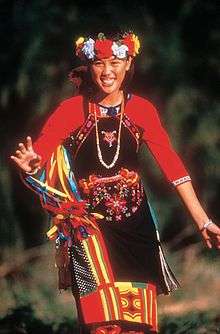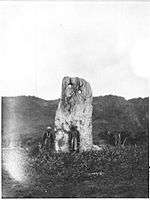Puyuma people
| Pinuyumayan | |
|---|---|
 | |
| Total population | |
| 14,081 (Jan 2018) | |
| Regions with significant populations | |
| Taiwan | |
| Languages | |
| Puyuma, Mandarin, Taiwanese Hokkien | |
| Religion | |
| Animism, Christianity | |
| Related ethnic groups | |
| Taiwanese Aborigines |

The Puyuma (Chinese: 卑南族; pinyin: Bēinán-zú; Pe̍h-ōe-jī: Puyuma-cho̍k, Pi-lâm-cho̍k), also known as the Pinuyumayan, Peinan or Beinan, are one of the indigenous groups of the Taiwanese aborigines. The people are generally divided into the Chihpen and Nanwang groups, both resident in Taitung County on the east coast of Taiwan.
In the year 2000 the Puyuma numbered 9,606. This was approximately 2.4% of Taiwan's total indigenous population, making them the sixth-largest indigenous group.[1] The Puyuma speak the Puyuma language, as well as Mandarin and Taiwanese Hokkien.
The name "Puyuma" means "unity" or "concord," and was originally the autonym of the speakers of the Nanwang dialect.[2] Zeitoun and Cauquelin (2006) also note that the word Puyuma can be analyzed as pu'-uma, which means "to send to the field."
Peinan Site
The earliest records of the prehistoric Peinan Site in Taitung City were made by Torii Ryūzō, an anthropologist in the early period of the Japanese occupation of Taiwan. During his four visits to Taiwan for anthropological research, he took photos of the monolithic stone pillars at the site. Beinan Cultural Park opened in 1997 to display and preserve the archaeological site, considered the most important one in Taiwan. An indoor/outdoor Museum of Prehistory opened in 2002.[3]
Villages
Puyuma villages include (ordered from north to south):[4]
- Ulibulibuk
- Bankio
- Alipai
- Pinaski
- Tamalakaw
- Rikabung
- Puyuma (Nanwang)
- Peinan
- Balangaw
- Apapalo
- Kasabakan
- Katipul
- Nirbuaqan
Notable Puyuma people
- A-mei, pop singer
- Paelabang Danapan, Vice President of Control Yuan
- Saya Chang, singer (and A-mei's younger sister)
- Erica Chiang, singer
- Jane Huang, singer of Taiwanese rock duo Y2J
- Samingad, singer
- Purdur, singer
- Panai, singer
- Tank, singer
- Sangpuy Katatepan Mavaliyw, Puyuma language singer
- Baday, author
- Kuciling Katatepan, traditional carver
- Iming, sculptor
See also
| Wikimedia Commons has media related to Puyuma People. |
References
- ↑ Directorate General of Budget, Accounting and Statistics, Executive Yuan, R.O.C. (DGBAS). National Statistics, Republic of China (Taiwan). Preliminary statistical analysis report of 2000 Population and Housing Census Archived 2007-03-12 at the Wayback Machine.. Excerpted from Table 28:Indigenous population distribution in Taiwan-Fukien Area. Accessed 8/30/06
- ↑ Teng, Stacy Fang-Ching (2008). A reference grammar of Puyuma, an Austronesian language of Taiwan. Pacific linguistics. 595. Canberra: Pacific Linguistics, Research School of Pacific and Asian Studies, Australian National University. ISBN 9780858835870.
- ↑ "The National Museum of Prehistory and Beinan Culture Park". Taiwan the Heart of Asia. 2013. Archived from the original on 2015-09-24. Retrieved 2016-12-14.
- ↑ Cauquelin, Josiane (1991). Dictionnaire puyuma-français. Paris: Ecole Française d'Extreme-Orient. ISBN 9782855395517.
External links
